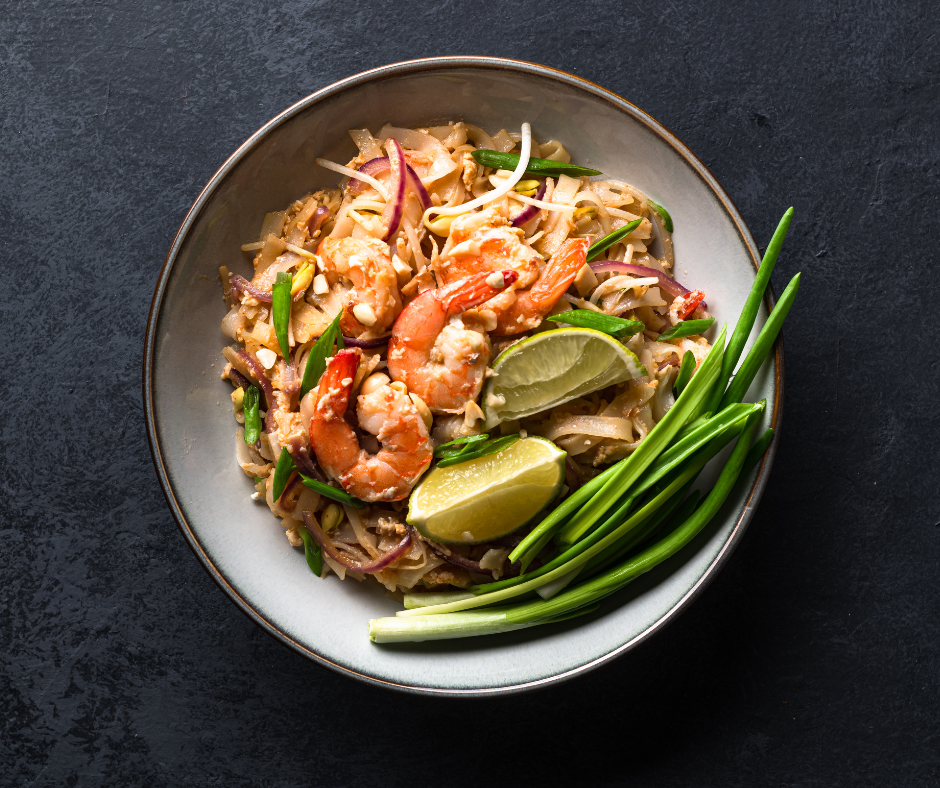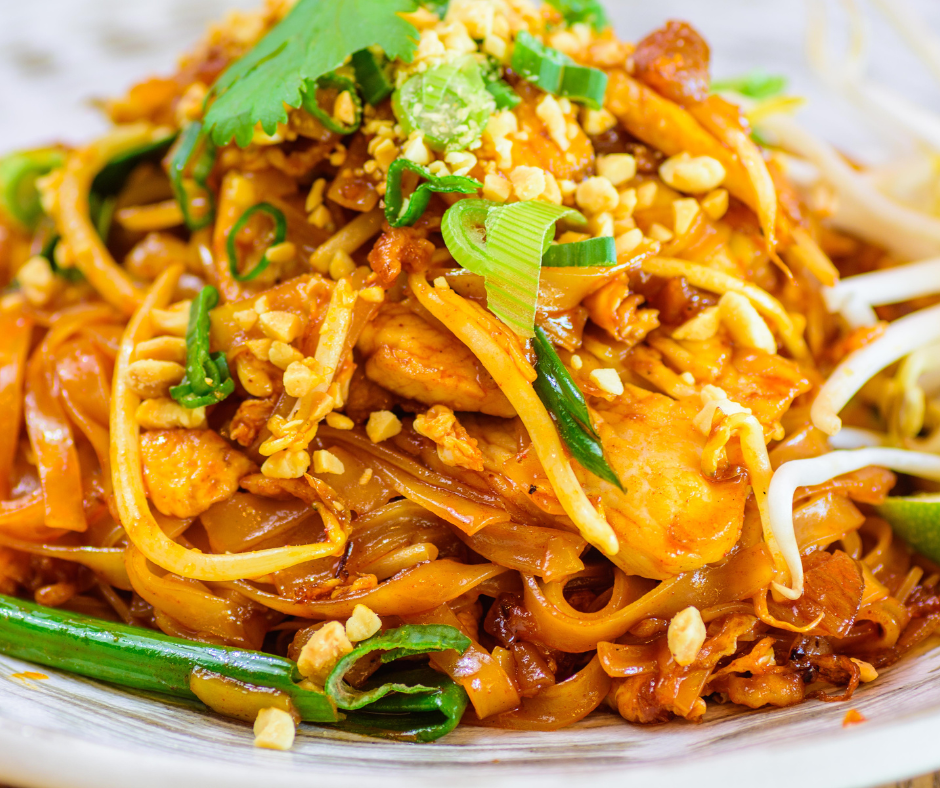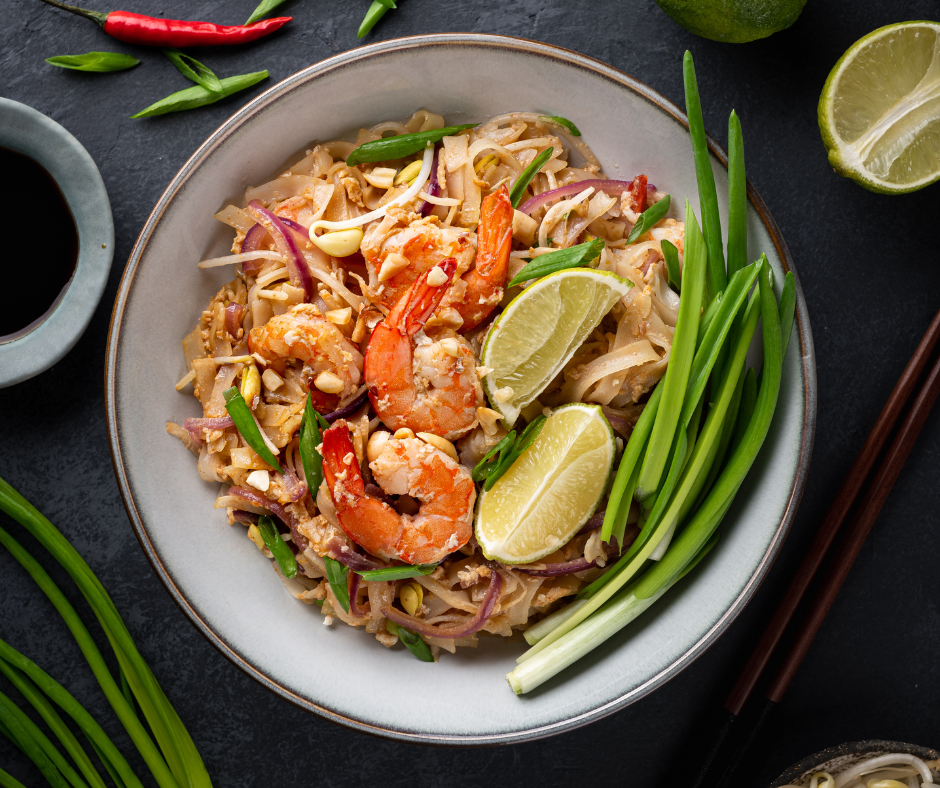Introduction
For individuals following a gluten-free diet, navigating the world of different cuisines and understanding which dishes are safe to consume is essential. With its wide range of flavors and ingredients, Thai cuisine can be a delicious option for those avoiding gluten. In this article, we will delve into the question, “Does Pad Thai Have Gluten?” and explore the gluten-free options in Thai cuisine.
Understanding Gluten And Its Impact On A Gluten-free Diet
Gluten is a protein found in wheat, barley, and rye. Consuming gluten can lead to various health issues for individuals with celiac disease or non-celiac gluten sensitivity. Following a gluten-free diet is crucial for their well-being.
When it comes to Thai cuisine, many dishes are naturally gluten-free. Traditional Thai cooking relies on rice, vegetables, fruits, herbs, and spices, with minimal use of gluten-containing ingredients. However, caution is important as some dishes contain soy sauce or other gluten-containing additives.
Exploring Thai Cuisine And Its Gluten-free Options
- Pad Thai: Pad Thai is among the most popular dishes worldwide. The primary ingredients in Pad Thai include rice noodles, shrimp or tofu, eggs, bean sprouts, and peanuts. While the original recipe does not contain gluten, variations may include soy sauce or oyster sauce, which can contain gluten. To ensure a gluten-free Pad Thai, it’s best to ask the restaurant or prepare it at home using gluten-free sauces.
- Tom Yum Soup: Tom Yum is a hot and sour soup that is typically gluten-free. This refreshing soup is packed with flavor and is made with lemongrass, lime juice, chili, and a combination of herbs. However, it’s advisable to check with the chef or restaurant staff to ensure no gluten-containing ingredients or thickeners are used in the soup.
- Green Curry: Green Curry is a popular Thai dish with spices, coconut milk, and vegetables or meat. The paste used to make the curry usually does not contain gluten. However, some restaurants may use pre-made curry pastes containing traces of gluten. It’s best to inquire about the specific ingredients to prepare the curry.
- Mango Sticky Rice: Mango Sticky Rice is a must-try for a delightful gluten-free dessert option. This traditional Thai dessert consists of sweet sticky rice topped with ripe mango slices and drizzled with coconut cream. It’s a simple yet indulgent treat that is safe for individuals on a gluten-free diet.
While these are just a few examples, there are many other gluten-free options in Thai cuisine, such as grilled meat or seafood with herbs, stir-fried vegetables, and fresh salads. Communicating your dietary restrictions and concerns to the restaurant staff is always recommended to ensure a safe and enjoyable dining experience.
In conclusion, Thai cuisine offers a range of gluten-free options that individuals can enjoy following a gluten-free diet. By understanding the basics of Thai cooking and being mindful of potential gluten-containing ingredients, you can savor the flavors of this vibrant cuisine without compromising your health.
Does Pad Thai Have Gluten?
For individuals with gluten sensitivity or celiac disease, dining out and trying new cuisines can be challenging. With its flavors, spices, and ingredients, Thai cuisine often leaves diners wondering, ‘Does Pad Thai Have Gluten?’. The answer is generally no! Pad Thai is gluten-free!
The Traditional Ingredients Of Pad Thai
Pad Thai is a popular Thai stir-fried noodle dish consisting of rice noodles, shrimp or chicken, tofu (for vegetarians/vegans), eggs, bean sprouts, peanuts, and a flavorful sauce. The beauty of Pad Thai lies in its simplicity and flexibility, as various ingredients can be added or substituted to suit different preferences.
The main ingredient, rice noodles, are naturally gluten-free and typically made from rice or rice flour. This makes them a safe alternative to wheat-based noodles. Additionally, most Pad Thai versions contain no gluten-containing grains or ingredients.
Ensuring Pad Thai Is Gluten-free By Avoiding Certain Sauces
While Pad Thai is traditionally gluten-free, paying attention to the sauces used in its preparation is essential. Some versions of Pad Thai sauces may contain soy sauce or other gluten-containing condiments. Here are a few tips to ensure your Pad Thai is gluten-free:
- Communicate your dietary needs: When ordering Pad Thai at a restaurant, inform the server about your gluten-free requirements. They can guide and assist in selecting a gluten-free option or modifying the dish accordingly.
- Avoid oyster sauce: Oyster sauce, a popular ingredient in some Pad Thai recipes, often contains wheat as a thickening agent. To ensure a gluten-free Pad Thai, request the omission of oyster sauce or check if the restaurant uses a gluten-free alternative.
- Opt for tamari or gluten-free soy sauce: Some Pad Thai recipes call for soy sauce, which typically contains gluten. However, gluten-free tamari or soy sauce alternatives are available, ensuring your Pad Thai remains gluten-free without compromising flavor.
- Make it at home: The best way to ensure a gluten-free Pad Thai is by preparing it yourself. This way, you can control the ingredients and use gluten-free sauces or alternatives.
By following these guidelines, individuals with gluten sensitivity or celiac disease can still enjoy the flavorful delight of Pad Thai without worrying about gluten.
In conclusion, Pad Thai is generally a gluten-free dish, with the key consideration being the sauces used in its preparation. You can indulge in this Thai delicacy worry-free by communicating your dietary needs and being mindful of the ingredients. Whether dining out or cooking at home, Pad Thai provides a delicious option for individuals seeking gluten-free cuisine.
Gluten-free Thai Dishes
Thai cuisine is known for its bold flavors and aromatic spices, but navigating through this cuisine can be challenging for those with gluten sensitivities or intolerances. However, the good news is that most Thai dishes can be made gluten-free with a few modifications.
Most Thai Dishes Can Be Made Gluten-free
Many traditional Thai dishes are naturally gluten-free or can be made gluten-free by substituting certain ingredients. Rice, rice noodles, and rice flour are staples in Thai cuisine and are naturally gluten-free. This means that dishes like Thai fried rice, green curry with rice noodles, and jasmine rice with stir-fried vegetables are all safe options for those following a gluten-free diet.
When dining out at Thai restaurants, it’s important to communicate your dietary needs to the staff to ensure your dish is gluten-free. Most restaurants are accommodating and will make the necessary adjustments to their recipes to accommodate gluten-free requests.
Popular Gluten-free Thai Dishes And Ingredients To Watch Out For
While many Thai dishes are safe for gluten-free individuals, a few dishes and ingredients may contain gluten or have the potential for cross-contamination. Here are some popular Thai dishes and ingredients to be cautious of:
- Pad Thai: Pad Thai is a popular dish that typically includes rice noodles, tofu or shrimp, eggs, and a sauce made from tamarind paste, fish sauce, and lime. The sauce can sometimes contain soy sauce, which often contains gluten. It’s important to ask the restaurant staff if they use gluten-free soy sauce or if they can make a gluten-free version of the dish.
- Curry pastes: Curry pastes are commonly used in Thai cuisine and can contain ingredients like shrimp paste or fish sauce, which may contain gluten. It’s crucial to check the ingredients list or ask the staff if the curry paste is gluten-free. Alternatively, you can make your gluten-free curry paste at home.
- Spring rolls: Spring rolls are a favorite appetizer in Thai cuisine, but they can sometimes be made with rice paper wrappers that contain wheat flour. Look for spring rolls made with rice paper, or ask the restaurant if they can make a gluten-free version.
- Soy sauce: Soy sauce is a key ingredient in many Thai dishes and can contain gluten. Look for gluten-free soy sauce or ask the restaurant if they can accommodate gluten-free requests.
By being aware of these potential sources of gluten and taking the necessary precautions, individuals with gluten sensitivities can still enjoy a wide variety of delicious and authentic Thai dishes.
In conclusion, while Thai cuisine can pose challenges for those following a gluten-free diet, most Thai dishes can be made gluten-free with a few modifications. Rice, rice noodles, and rice flour are gluten-free staples in Thai cuisine, making many dishes safe. However, it’s important to be cautious of certain dishes and ingredients, such as Pad Thai, curry pastes, spring rolls, and soy sauce, which may contain gluten or have the potential for cross-contamination. By communicating your dietary needs to restaurant staff and being vigilant about ingredient labels, you can still enjoy the flavors of Thai cuisine while avoiding gluten.
Navigating Thai Restaurants For Gluten-free Options
For individuals following a gluten-free diet, finding suitable dining options can sometimes be a challenge. Thai cuisine, known for its vibrant flavors and unique combinations, may raise questions about gluten content. This article aims to provide some guidance on navigating the world of gluten in Thai cuisine.
Tips For Dining Out In Thai Restaurants While Following A Gluten-free Diet
When dining in Thai restaurants, here are some helpful tips for individuals following a gluten-free diet:
- Ask about ingredients: Communicate your dietary restrictions to the restaurant staff and inquire about the ingredients used in the dishes you are interested in. Some common ingredients to be cautious include soy sauce, oyster sauce, and wheat-based noodles.
- Choose naturally gluten-free options: Thai cuisine offers several dishes that are naturally gluten-free, such as grilled meats, seafood, stir-fried vegetables, and curries made with coconut milk. Stick to these options to minimize the risk of gluten contamination.
- Be cautious of cross-contamination: Cross-contamination can occur in a shared kitchen environment. Request that your food be prepared in a separate area with clean utensils and pans to reduce the risk of gluten exposure.
- Consider rice-based dishes: Rice is a staple in Thai cuisine and is a gluten-free alternative to wheat-based noodles. Opt for rice-based stir-fries, fried rice, and rice noodle soups to indulge in Thai flavors without worrying about gluten.
- Seek out gluten-free alternatives: Some Thai restaurants have recently started offering gluten-free alternatives to popular dishes. Look for menus or ask the staff if they have gluten-free options.
Miami’s Gluten-free Thai Food Scene: Where To Find Delicious Options
In Miami, several Thai restaurants cater to gluten-free diners. Here are a few worth exploring:
- Phuket Thai Restaurant: This establishment offers a dedicated gluten-free menu featuring a range of tantalizing dishes, from gluten-free Pad Thai to gluten-free curries.
- Sea Siam Thai Restaurant: Known for its authentic Thai flavors, Sea Siam offers a gluten-free menu with various options, including gluten-free spring rolls and ginger chicken.
- NaiYaRa: While not exclusively a Thai restaurant, NaiYaRa offers gluten-free Thai dishes that are both delicious and inventive. Their gluten-free options include crispy rice salad, green curry, and fried pineapple.
It is always recommended to call ahead and confirm the availability of gluten-free options at these establishments, as menus may change or preferences may vary.
In conclusion, navigating Thai restaurants for gluten-free options can be made easier by communicating your dietary needs, choosing naturally gluten-free dishes, being cautious of cross-contamination, and seeking out establishments that offer gluten-free alternatives. In Miami, restaurants like Phuket Thai, Sea Siam, and NaiYaRa provide delicious gluten-free Thai cuisine options. With these tips and recommendations, individuals following a gluten-free diet can still indulge in the flavors of Thai cuisine without compromising their health.
FAQ: Does Pad Thai Have Gluten? Navigating the World of Gluten in Thai Cuisine
Q: Is Pad Thai gluten-free?
A: Pad Thai can be gluten-free if prepared with certain modifications. The traditional Pad Thai recipe includes rice noodles, which are gluten-free. However, you need to ensure that the sauce and other ingredients used in the dish are free from gluten.
Q: What should I look out for when ordering Pad Thai?
A: When ordering Pad Thai, it’s important to ask about the gluten-free status of the sauce. Some versions of Pad Thai sauce may contain soy sauce or other ingredients that contain gluten. It’s best to inform your server or the restaurant staff about your gluten-free requirements and ask them to prepare the dish accordingly.
Q: Can I request gluten-free rice noodles for my Pad Thai?
A: Yes, you can request rice noodles instead of egg noodles for your Pad Thai. Rice noodles are typically gluten-free. However, it’s always a good idea to confirm with your server that the rice noodles being used are indeed gluten-free to avoid any potential cross-contamination.
Q: Are there any other Thai dishes that are naturally gluten-free?
A: Yes, Thai cuisine offers a variety of naturally gluten-free dishes. Some examples include Tom Yum soup, green curry with rice, stir-fried vegetables with cashew nuts, and mango sticky rice. However, it’s always recommended to double-check with the restaurant or the person preparing the food to ensure there are no hidden sources of gluten.
Q: What precautions can I take to avoid gluten cross-contact?
A: To minimize the risk of gluten cross-contact, it’s important to communicate your dietary needs clearly to the restaurant staff. Ask them to use separate utensils, pans, and surfaces when preparing your gluten-free dish. Avoid fried items that may be cooked in shared oil, and opt for steamed or pan-seared options instead.
Q: Where can I find gluten-free ingredients used in Thai cuisine?
A: Most gluten-free ingredients used in Thai cuisine, such as rice noodles, coconut milk, and various spices, can be found in specialty food sections of grocery stores or international food markets. It’s always helpful to read ingredient labels to ensure they are gluten-free certified.
Conclusion
Now you know the answer to ‘Does Pad Thai Have Gluten?’. Discovering the flavors of Thai cuisine while adhering to a gluten-free lifestyle is possible. While some Thai dishes may require careful consideration of certain ingredients, many delicious and naturally gluten-free options exist. Whether indulging in Pad Thai made with gluten-free sauces or exploring other traditional Thai dishes, embracing Thai cuisine’s diverse and vibrant world can be a delightful culinary journey for gluten-free individuals. So go ahead, savor the tantalizing flavors of Thai cuisine, and enjoy a gluten-free dining experience!
Embracing The Flavors Of Thai Cuisine While Maintaining A Gluten-free Lifestyle
For individuals following a gluten-free diet, exploring diverse culinary options can sometimes be challenging. Thai cuisine, known for its rich flavors and vibrant spices, offers a variety of gluten-free options to satisfy your taste buds while keeping your dietary needs in check.
When it comes to Thai food, one popular dish that may raise concerns for gluten-sensitive individuals is Pad Thai. Traditionally, Pad Thai is made using naturally gluten-free rice noodles. However, it’s essential to be aware of potential sources of gluten that may be present in the sauces and ingredients used in its preparation. Some soy sauces or oyster sauces may contain gluten, so it’s crucial to communicate your dietary requirements to the restaurant or chef if you are dining out.
Exploring The Diverse And Gluten-free Delights Of Thai Food
The good news is that Thai cuisine offers a wide range of gluten-free options beyond Pad Thai. Here are a few popular gluten-free dishes to explore:
- Tom Yum Soup: This tangy and aromatic soup typically consists of shrimp or chicken, mushrooms, lemongrass, lime leaves, and spices. It is typically gluten-free, but checking with the restaurant regarding any hidden ingredients is always recommended.
- Mango Sticky Rice: A delicious dessert with sweet rice, fresh mango slices, and a sprinkle of toasted sesame seeds. It’s naturally gluten-free and a delightful treat to end your Thai meal on a sweet note.
- Green Curry: Made with a flavorful blend of green curry paste, coconut milk, vegetables, and your choice of protein, this curry dish is typically gluten-free. However, some brands of curry paste may contain gluten, so it’s important to read labels or ask your server for gluten-free options.
- Thai Salad: A refreshing mix of crisp vegetables, herbs, and a tangy dressing, Thai salads are often a safe gluten-free choice. Be cautious of dressings or sauces containing gluten, and opt for gluten-free alternatives when necessary.
Remember, when dining out, it’s always helpful to communicate your dietary needs and ask questions about ingredients and preparation methods. Additionally, you can prepare Thai dishes at home using gluten-free ingredients and sauces for complete control over your meal.



